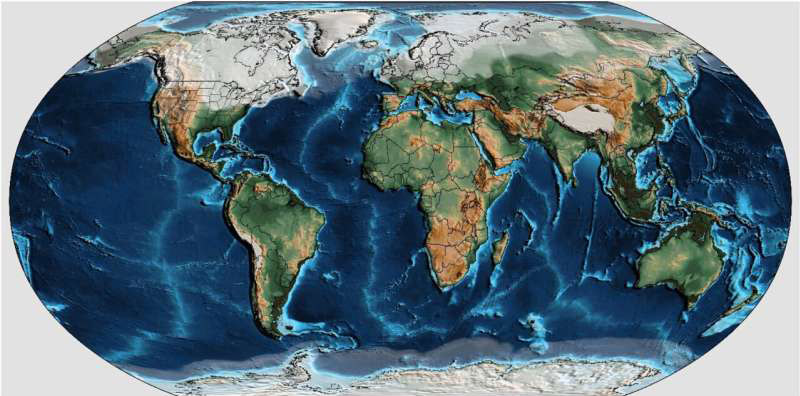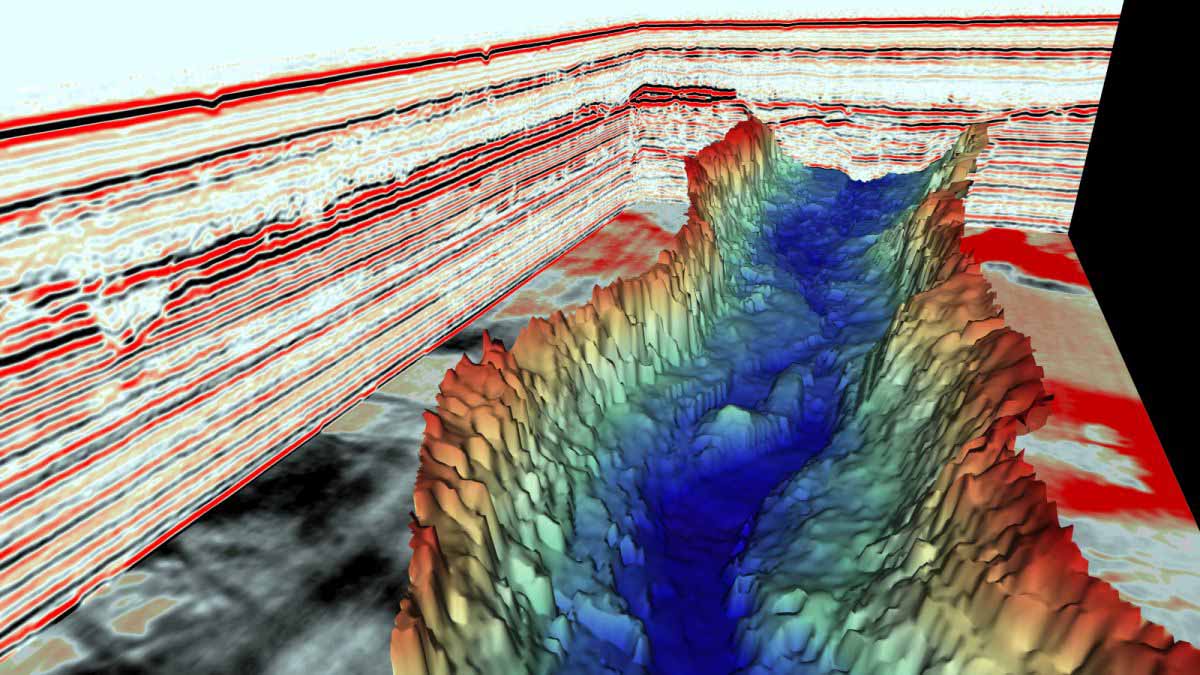

A sea is a large body of water that is part of surrounding waters or is surrounded in whole or in part by land. More broadly, the sea (with the definite article, also called the World Ocean) is the interconnected system of the Earth's salty, oceanic waters, including the IHO's four named oceans - the Atlantic, Pacific, Indian, and Arctic - and the waters of the Southern Ocean, either considered separately or included within the other four.
The sea moderates the Earth's climate and has important roles in the water cycle, carbon cycle, and nitrogen cycle. Although the sea has been travelled and explored since prehistory, the modern scientific study of the sea- oceanography - dates broadly to the British Challenger expedition of the 1870s. The sea is conventionally divided into four or five large sections, such as the Pacific, called oceans while smaller sections, such as the Mediterranean, are known as seas.
Owing to the present state of continental drift, the Northern Hemisphere is now fairly equally divided between land and sea (a ratio of about 2:3) but the South is overwhelmingly oceanic (1:4.7). Salinity in the open ocean is generally in a narrow band around 3.5% by mass, although this can vary in more landlocked waters, near the mouths of large rivers, or at great depths.
About 85% of the solids in the open sea are sodium chloride. Deep-sea currents are produced by differences in salinity and temperature. Surface currents are formed by the friction of waves produced by the wind and by tides, the changes in local sea level produced by the gravity of the Moon and Sun. The direction of all of these is governed by surface and submarine land masses and by the rotation of the Earth (the Coriolis effect).
Former changes in the sea levels have left continental shelves, shallow areas in the sea close to land. These nutrient-rich waters teem with life, which provide humans with substantial supplies of food - mainly fish, but also shellfish, mammals, and seaweed - which are both harvested in the wild and farmed. The most diverse areas surround great tropical coral reefs. Whaling in the deep sea was once common but whales' dwindling numbers prompted international conservation efforts and finally a moratorium on most commercial hunting.
Oceanography has established that not all life is restricted to the sunlit surface waters: even under enormous depths and pressures, nutrients streaming from hydrothermal vents support their own unique ecosystem. Life may have started there and aquatic microbial mats are generally credited with the oxygenation of Earth's atmosphere; both plants and animals first evolved in the sea.
The sea is an essential aspect of human trade, travel, mineral extraction, and power generation. This has also made it essential to warfare and left major cities exposed to earthquakes and volcanoes from nearby faults; powerful tsunami waves; and hurricanes, typhoons, and cyclones produced in the tropics.
This importance and duality has affected human culture, from early sea gods to the epic poetry of Homer to the changes induced by the Columbian Exchange, from Viking funerals to Basho's haikus to hyperrealist marine art, and inspiring music ranging from the shanties in The Complaynt of Scotland to Rimsky-Korsakov's "The Sea and Sinbad's Ship" to A-mei's "Listen to the Sea". It is the scene of leisure activities including swimming, diving, surfing, and sailing. However, population growth, industrialization, and intensive farming have all contributed to present-day marine pollution.
Atmospheric carbon dioxide is being absorbed in increasing amounts, lowering its pH in a process known as ocean acidification. The shared nature of the sea has made overfishing an increasing problem. Continue reading
Scientists stunned by colossal formations hidden under the North Sea Science Daily - August 14, 2025

Massive buried sand mounds under the North Sea, formed millions of years ago, are defying geological norms and could change energy exploration and carbon storage strategies. Scientists have uncovered colossal sand formations, dubbed “sinkites,” that have mysteriously sunk into lighter sediments, flipping the usual geological order. Formed millions of years ago by ancient earthquakes or pressure shifts, these giant structures could reshape how we locate oil, gas, and safe carbon storage sites. The discovery not only challenges established geology but also introduces a new partner phenomenon, “floatites,” and sparks debate among experts.
Scientists reconstruct 540 million years of sea level change in detail PhysOrg - July 7, 2025

Sea level on Earth has been rising and falling ever since there was water on the planet. Scientists were already able to use sediments and fossils to roughly reconstruct how sea levels changed over time steps of a million years or more.
Silver is being buried beneath the sea, and it's all because of climate change, study finds Live Science - September 3, 2024
Global warming is burying huge amounts of silver beneath the South China Sea - and the same could be happening across the world's oceans, scientists say. The amount of silver trapped in marine sediments off the coast of Vietnam has increased sharply since 1850, the new study shows. This coincides with the start of the Industrial Revolution, when humans began pumping greenhouse gases into the atmosphere on a large scale.
'Death throes' of ancient ice sheets carved hidden valleys below the seafloor. The subterranean structures could provide clues about how modern ice sheets will react to climate change. Live Science - October 8, 2022

Hidden valleys buried beneath the ocean bottom in the North Sea were rapidly carved out during the "death throes" of an ancient ice sheet toward the end of the last ice age around 20,000 years ago, a new study shows. The surprising subterranean structures could yield clues as to how modern ice sheets will react to rapid warming caused by climate change, researchers say.
The buried structures, known as tunnel valleys, are massive underground ravines that were etched into the ancient seafloor by meltwater that drained into channels underneath the ice sheets. The immense weight of the rapidly melting slabs of ice forced the flowing water to cut deep canyons into the seafloor; those channels have since been covered by hundreds of meters of sediment buildup. Tunnel valleys can measure up to 93 miles (150 kilometers) long, 3.7 miles (6 km) wide and 1,640 feet (500 meters) deep, according to a statement by researchers (opens in new tab).
<Video: Massive Sinkholes Break Open As Dead Sea Shrivels ABC - March 20, 2015
There are more than 3,000 sinkholes on the banks of the Dead Sea -- and they're multiplying exponentially, according to environmentalists, as the body of water dries up. "It's nature's revenge," said Gidon Bromberg, the Israeli Director at EcoPeace Middle East, an organization that brings together Jordanian, Palestinian and Israeli environmentalists to protect their shared environmental heritage. These sinkholes are a direct result of the inappropriate mismanagement of water resources in the region. More than 1,400 feet below sea level, the Dead Sea is the lowest point on land. The first sinkhole was spotted in the 1980s. By 1990, there were 40, and 15 years later new chasms are breaking open every day.
Scientists drill beneath Dead Sea in search of priceless data PhysOrg - December 22, 2010
Rock samples that have been underwater for millions of years are likely to be better preserved, they say, than samples taken from under an exposed surface, which can be damaged by aridity and erosion. As a result, the Dead Sea bore hole is expected to contain priceless information about the planet's past and to offer insight on its future. Expectations are high that the lowest place on Earth can answer questions on climate change, earthquake risk and untapped natural resources.
Mediterranean most threatened sea on Earth PhysOrg - August 2, 2010
The Mediterranean Sea's exquisitely rich mix of flora and fauna is more threatened than marine life anywhere else on Earth, according to a landmark scientific survey released Monday.
Mediterranean Sea Getting Saltier, Hotter Live Science - May 24, 2010
Western Mediterranean increases by 0.0036 degrees Fahrenheit (0.002 degrees Celsius), and its salt levels increase by 0.001 units of salinity, researchers monitoring the sea found. The change is consistent with the expected effects of global warming. These changes may sound like small beans, but they have been building up at a faster pace since the 1990s, the study, detailed in the April 1 edition of the Journal of Geophysical Research, suggests. The results show a consistent trend, "but to confirm this accelerating trend, we need to monitor it over the years to come," said study author Manuel Vargas-Yanez of the Spanish Institute of Oceanography.
Red Sea coral reefs get their complex shape from an ancient 'seabed template'. BBC - February 23, 2010
Red Sea coral reefs get their complex shape from an ancient 'seabed template', say scientists. Their distinctive appearance can be seen clearly in satellite images of the region and has its origin in seabed erosion thousands of years ago. The scientists say the corals have simply adopted and accentuated the pattern created in once-exposed rock moulded by heavy rains.
Colossal Flood Created the Mediterranean Sea Live Science - December 9, 2009
The Mediterranean Sea as we know it today formed about 5.3 million years ago when Atlantic Ocean waters breached the strait of Gibraltar, sending a massive flood into the basin. Geologists have long known that the Mediterranean became isolated from the world's oceans around 5.6 million years ago, evaporating almost completely in the hundreds of thousands of years that followed. Scientists also largely agree that the Mediterranean basin was refilled when the movements of Earth's crustal plates caused the ground around the Gibraltar Strait to subside, allowing the ocean waters of the Atlantic to cut through the rock separating the two basins and refill the sea. But exactly how the waters cut their way through and how long it took them to do so wasn't known.
Ancient Mediterranean flood mystery solved BBC - December 9, 2009
Research has revealed details of the catastrophic Zanclean flood that refilled the Mediterranean Sea more than five million years ago. The flood occurred when Atlantic waters found their way into the cut-off and desiccated Mediterranean basin. The researchers say that a 200km channel across the Gibraltar strait was carved out by the floodwaters. Their findings, published in Nature, show that the resulting flood could have filled the basin within two years.